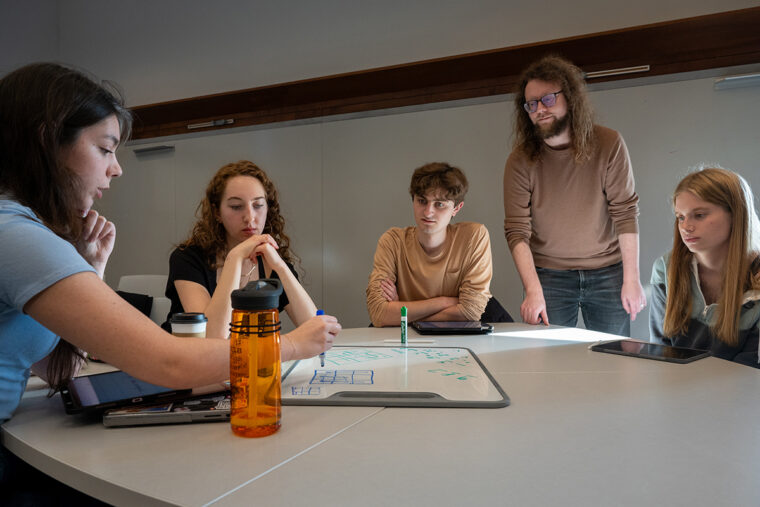
With the U.S. presidential election held just two days prior, students in Ben Wormleighton's "ESE 3090 Modeling & Design in Social Choice Systems" course in the McKelvey School of Engineering at Washington University in St. Louis arrived to address the voting process of a different nation: Gridlandia.
In groups, they gathered around 3×3 grids representing the fictional land to try their hands at redistricting. Their objective: Find all possible district maps for the grid, then determine how these maps capture voter opinions by assigning votes to each square and computing the number of seats won by each party.
The inquiry-based class, now in its second year, addresses modeling and design challenges in social choice systems - from the way we split the check to the way we elect a president - by using math and software tools. It's different from what many would consider the typical engineering class, and that's the point.
"It's pretty unique," said Wormleighton, a lecturer in the Preston M. Green Department of Electrical & Systems Engineering. "There's a real hunger at WashU for learning that's both quantitatively rigorous and socially relevant - and an eagerness to talk about ethical problems within the engineering context."
Wormleighton said systems engineering essentially allows engineers to look inside the "black boxes" that communal decision-making processes often become.
"For instance, we usually can't account for all possibilities in these decision-making spaces, so we might take a probabilistic approach," he said. "It's a systems analysis like you might do as an engineer, but you're applying it to problems of economics and political science. The tools and the philosophy are what make it engineering."
On this day, the class is pivoting its attention away from discussing fairness in redistricting and moving toward identifying gerrymandering, the name given to the process of manipulating electoral district boundaries for the gain (or detriment) of a particular party or social class. Over the past decade, there has been a revolution in our ability to detect likely cases of gerrymandering, with simple "by eye" inspection replaced by advanced computer algorithms relying on sophisticated user data. Identifying manipulation will require students to compare districts and spot outliers in their data.
To do that, they'll need maps - lots of them.
"Ultimately, this class is about one-third coding," Wormleighton said. "We'll be generating thousands of district maps to try to get a cross-section representative of the whole. Then you can see how far your map is to the right or left on certain metrics."
The irony?
"Most maps are utterly useless," he said, "so we have to find a way to focus on the ones that matter."
The timing of the subject matter is right for the students huddled around Gridlandia, discovering how different distributions of electoral voters can lead to drastically different outcomes.
Michaela Sewall, a senior majoring in systems science and engineering, said she appreciates that the upper-level course encourages "thinking broadly about the real-world implications and impact that we can have in society as engineers."
Daniel Ruskin, a senior majoring in computer science with a second major in systems science and engineering, agreed, noting that the timing of the class also gives him the opportunity to "connect what you learn in the classroom with what's happening in real life, not only with the presidential election but with Amendment 7 on the ballot in Missouri, understanding what banning ranked-choice voting would really mean."
Enrique Rivera, a sophomore majoring in mechanical engineering with a second major in systems science and engineering, praised Wormleighton's approach to leading the class, saying, "He really wants a wide range of people's perspectives, and he asks for continuous feedback to see what you're getting out of the class."
To further broaden the students' perspectives, Wormleighton invites speakers from the School of Law and the Department of Mathematics in Arts & Sciences to speak to the class. It's all part of expanding the view they have of engineering - and their role in the field.
"These students have been building skills in a traditional engineering context," Wormleighton said. "Now we're asking them to develop a vision for their computational and mathematical fluencies that leads them to address socially relevant issues. Mathematicians and engineers are showing up in places like courtrooms to debate these issues."
Above all, he said he hopes students leave the class with a skill that will guide their work in the years to come.
"An overall competence to rigorously interrogate the projects they work on with a fairness and equity lens - that's the goal."
This story was originally published on the McKelvey Engineering website.






